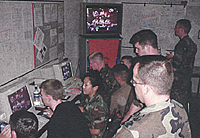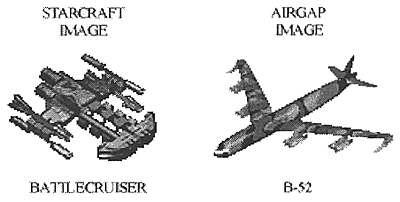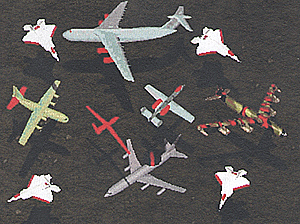Aerospace Basic Course Wargame
presented by Capt. Scott Neiper
 The USAF instructor has four weeks to teach the Aerospace Basic Course, a first stop for newly minted second lieutenents to learn the six "core competencies" and other aspects of aerospace doctrine. These new officers start with books and other readings, include videos and other instructional tapes, and then...well, here's where Capt. Scott Neiper, an ABC instructor, comes in. He created an interactive exercise to cement these six core elements in the minds of students.
The USAF instructor has four weeks to teach the Aerospace Basic Course, a first stop for newly minted second lieutenents to learn the six "core competencies" and other aspects of aerospace doctrine. These new officers start with books and other readings, include videos and other instructional tapes, and then...well, here's where Capt. Scott Neiper, an ABC instructor, comes in. He created an interactive exercise to cement these six core elements in the minds of students.
A session of AIRGAP, usually two or three students per monitor/position, with one or two others in a coordinating role behind them. The monitor in the corner of the room on a pedastal shows a live image of one of the screens.
This in itself is not a particularly unique idea--plenty of instructors use exercises, or wargames. But what Neiper, Captain Owen Morgan, and Captain George Culver did went above and beyond the call of instructional duty. They adapted a commercially available sci-fi wargame, StarCraft, into an Air Force training simulation called AIRGAP, that is, in a word, impressive.
What is AIRGAP?
Like all the other acronym branches of the military, the government in general, and corporate America, AIRGAP is an acronym for the six core competencies:
- Aerospace Superiority
Information Superiority
Rapid Global Mobility
Global Attack
Agile Combat Support
Precision Engagement
Now, this is all wonderful theory, and indeed, reading the case study paper on AIRGAP, you start the sonorous process of "multimodal learning,""affective learning," and other academia phrasings which boil down to the old adage: "to hear is to forget, to write is to learn, and to do is to remember." AIRGAP definitely falls under the "do" part of the adage.
StarCraft is a pretty typical real-time wargame. Human space-borne forces (marines, tanks, hovercraft, and other sci-fi staples) fight other aliens on distant planets. The game can be played across a network. Like most of these build and conquer games, you as the player must control everything from the collection of resources to creating forces, to tactical deployment in real time. It's a lot for one player to handle, but that's pretty typical of these style of wargames.
However commercially successful, this is a pretty bad simulation of any type of US force capability. What this trio of folks did was alter StarCraft and create an US Air Force training mission. It is not an exact match to a particular mission, say, Afghanistan, but it is like the typical "Red vs. Blue" simulations run throughout our military.
StarCraft comes with a scenario editor, so you can create your own maps and play custom missions. Neiper and cohorts took that scenario editor and custom made missions with specific units to show how an air campaign could be waged.
Furthermore, they made use of the networking capabilities and divided the various tasks among the four player "flights" that acted together as a team. Thus, you have a logistics, intel, offensive force, and defensive force functions--and one cannot intrude on the others. Thus, the logistics officer cannot move A-10s, the F-22 drivers can't deploy special forces, and so on.
Those teams with enough smarts to apply the six core competencies would, or should, do better than those who sputter and flutter around without appreciation for USAF doctrine. That doctrine, by the way, won the Gulf War, so don't dismiss it out of hand.
And indeed, the 1.0 version did just that. However, it kept all the original sci-fi graphics, and even though the text was changed, a B-52 just didn't look like a B-52, and students complained they couldn't figure out what was what.
Improvements
 Last year at Connections, I saw a partial demo of AIRGAP. Frankly, I didn't understand much of it or what it was trying to portray. It sounded good, but like all demos, it was quick. So, all I could think of was, "Nice battlecruisers."
Last year at Connections, I saw a partial demo of AIRGAP. Frankly, I didn't understand much of it or what it was trying to portray. It sounded good, but like all demos, it was quick. So, all I could think of was, "Nice battlecruisers."
AIRGAP: Before and After
However, this year, I saw version 2.0, and even more important than that, I actually sat at one of the stations and played a full game. As I mentioned before, impressive.
First off, the "cool factor" has been upped. Neiper used freeware to peel back the layers of the StarCraft scenario editor and build his simulation from the ground up, so to speak. First, he redid most of the graphics using a 3D graphics program. A B-52 now looks like a B-52, and so on. Second, he rewrote a significant number of internal macros, he calls them "triggers," so that the program does things at certain times. For example, when you build up a base enough, you receive mobile AAA batteries--a C-5 flies on the board and drops them off at your base. If you take out a sector missile defense command center, all the SAM sites connected to that center no longer fire missiles at the enemy. Destroy a couple other buildings and you don't receive any re-inforcements.
"The whole map is nothing but a big 'if-then' statement," Neiper quipped. Not that it was easy to do. Indeed, if you change one thing and the new element is just a little off, the entire program crashes. For example, each of the units consists of 36 rotations (and some like the C-130 consist of 72 rotations), which means a distinct image. If you look at a clock face, and each of the hours as a rotation, you'd say the image of the hour hand has 12 rotations. Each ha to be created, and each must match the pixel size exactly. So, for example again, the C-130 is 84 pixels by 84 pixels. Do 85x85 and the program crashes. Do 84x62 and the program crashes. You can bet Neiper had a lot of experience in crashed StarCraft, or more properly, crashed AIRGAP, as he and the other two developed the simulation.
The other aspect they changed was the "gaming points." Since some officers would have been familar with StarCraft as, well, StarCraft, they changed the internal parameters so that AIRGAP would reflect USAF doctrine and unit capabilities, not gamey moves. That way, all students would be starting on a level playing field.
 AIRGAP: The Game
AIRGAP: The Game
Well, knowing none of the intracasies of USAF core competencies, but with a passing familiarity of StarCraft, I plunged into the tutorial along with seven other newbies. I was on the side of Freedomland, and the enemy Republica needed more than a tongue lashing to mend its evil ways. Eight other Republica players went through the tutorial as well. Each tutorial matched the player's position.
A mixture of aero icons from the simulation: AWACS, A-10, C-130, F22, B-52, and more.
Knowing that "amateurs study tactics and professional study logistics," I was the logistics officer for Freedomland. The tutorial took me through transporting fuel to the appropriate spot and building logistics centers for ever-increasing missions. No fuel, and the "pilots are just pedestrians." No logistical centers an no additional units could enter the base for deployment against the enemy. I could repair the various buildings around the base, and I could create up to two Forward Air Bases (pre-designated--I don't get to pick the location). As it turns out, each base was on an island. I had a C-130 at my disposal to move my logistics troops (looks like a HummVee) to the islands and create the base.
I also had specific goals: build a certain number of logistical centers and move enough fuel points by a certain time. Success brings in additional forces. Delays means our re-inforcements don't arrive. And failure, well, failure means nothijng more comes in.
The exercise started and I immediately sent six of my eight troops to get the fuel while two built logistical centers. I hit my marks ahead of time and even established both Foward Air Bases. And then. Well, and then I sat. I mean not really. I continued to build logistical centers because I had additional time and resources.
Meanwhile, strike and counterstrike packages went back and forth between Freedomland and Republica, although from my perspective, we seemed to be losing an awful lot of SAMs and planes and not exacting much in return. Oh, logistics kept its end up--we never missed a target goal, and I built over capacity.
The rest of it, well, was a catastrophe. They seemed to penetrate at ease and pick off our important buildings. I ended up losing most of my HummVees to strafing, and our main tower and airfield were smoking ruins in not too long. Our defensive forces player never got the hang of moving assets (the mobile AAA batteries sat where they were dropped off, until picked off one at a time by enemy fighters and stealth fighters. Man, we felt like the raw rookies we were. We had enough trouble vectoring information--there are no grid coordinates--so we were reduced to describing locations:
- "Enemy A-10s and F22s over the first island."
"Which island?"
"The first one, due south of the main base."
"On the main base?"
"No, the island below the main base. Halfway down the left side of the screen."
 Those directional terms, by the way, are official Fredomland military secrets, and if we had not been overrun by Republica, I would have had to terminate you for reading them.
Those directional terms, by the way, are official Fredomland military secrets, and if we had not been overrun by Republica, I would have had to terminate you for reading them.
The hospital, like a Chinese embassy, shouldn't be a target.
It was after the game ended with a Republica victory that we learned that none other than Neiper played the offensive force player! Sheesh, no wonder they were so effective on the offense.
Conclusions
Still, the exercise points out the idea of the six core competencies--or in our case, the six incompetencies--as well as the ability to communicate (or not) within a team, and the abilities of an experienced (or expert) officer against poorly trained recruits. I also imagine that there are some aspects that come out after repeated play that escape my one-shot deal.
AIRGAP shows what can be done by a motivated instructor to impress specific ideas on students, and hopefully, allow students to learn--and remember--basic information and doctrine. Surely it will not be soon that I will forget sitting in the logistics chair and trying to balance what I need to accomplish with the resources at hand. In some cases it was simple, but as the "war" wore on, and logistical assets evaporated, the goals were increasingly difficult to meet.
Note that these modifications are not available to the general public. Blizzard Inc. gave specific permission for some of the changes under the condition that such modifications go nowhere but specific labs. So, you guys are out of luck. However, all the tools to make your on changes are available on the Web. So, if you have the inclination and plenty of time and patience, you too can create your very own simulation.
Bio
Capt. Scott Neiper - USAF, Wargame Designer, and Author Capt. Neiper is the Chief of the Wargaming Division, Squadron Officer College (SOC). In his position at SOC, he represents the Air and Space Basic Course (ASBC) and Squadron Officer School (SOS). His responsibilities include the execution of five unique wargames executed at least 15 times per year with over 8000 students participating. He is lead designer/creator of the AIRGAP wargame based on the commercial wargame Starcraft that is currently in use at ASBC. This past November, Capt. Neiper published the paper "Affective Doctrinal Education: Case Study in Air Force Core Competency Education" at the Interservice/Industry Training, Simulation and Education Conference, covering AIRGAP's use at ASBC. Capt Neiper has a BA in History from Miss. State University.
More Connections 2002
- Welcome and Introduction
Flight and Airport Security
Lecture: Gulf War: Perpectives and Prospects 10 Years Later (Col. John A. Warden III)
Lecture: Lessons from an Expeditionary Air Campaign: North Africa 1942-3 (John Hill)
Lecture: Air Command and Staff College (Lt. Col. Scott Lewis)
AIRGAP: Aerospace Basic Course Wargame (Capt. Scott Neiper)
Lecture: Air War College (Dr. Michael Hickok)
Lecture: Stalin's Dilemma (Dr. Ed Bever)
Lecture: National Defense University (Dr. Lee Blank)
Lecture: Military History and Wargaming (Martin Campion)
Lecture: Wargaming at SAMS School of Advanced Military Studies (Dr. William J. Gregor)
Lecture: Educating Campaign Strategists: UK Joint Services Command and Staff College (Wing Commander Steve Dean)
Lecture: US Air Force Academy Wargaming (Maj. Rick White)
Lecture: Building the Foundation of Military Simulations: US Naval Academy (Lt. Andrew Biehn)
Mingling: Making Connections
Saturday: Using The USAF Archives
Back to List of Conventions
Back to Travel Master List
Back to MagWeb Master List of Magazines
© Copyright 2002 by Coalition Web, Inc.
This article appears in MagWeb (Magazine Web) on the Internet World Wide Web.
Other military history articles and gaming articles are available at http://www.magweb.com